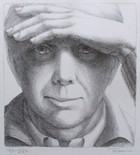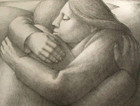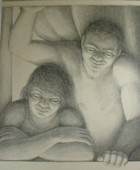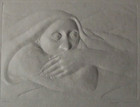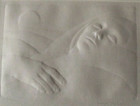George Tooker
(1920-2011)
Art need not be openly religious in subject matter to summon up a sense of the sacred. While wandering through a retrospective show of tempera paintings by American Artist George Tooker at the Columbus (Ohio) Museum of Art in the summer of 2009, I was instantly drawn to a panel titled Bird Watchers. It depicted eight people, gathered under a tree with roosting birds in New York’s Central Park. It was a simple enough subject, yet there was something mysterious about the uniform features of these bird watchers, the iconographic gestures of their hands, and the look of wonder in their eyes--almost as if they had just witnessed the Ascension!
Later, I saw intimations of a Pieta in a woman, cradling a sleeping man, among a group of Coney Island bathers. A scene of a black man sharing a loaf of bread with two white companions suggested the Supper at Emmaus. Harried commuters in the painting, The Subway, evoked the damned, descending the circles of a modern, urban hell. I had discovered a “secular” icon-writer.
Tooker watched artistic trends come and go during his long artistic career but always remained faithful to the figurative style of painting he first adopted in the 1940s. In this mystical aesthetic world, distinctive markings of age, gender, and race blur, and the specific gives way to the universal. Tooker’s figures seem poised on the threshold between dream and reality, sleep and consciousness, life and death, the world of the flesh and the kingdom of the spirit. Some peer out of windows or gaze into mirrors. Others lie suspended in comatose states, mimicking death or spiritual awakening.
Tooker probed how humans relate (and do not relate) to one another, moving, as one critic puts it, “from anxiety to agape” (the Greek word for spiritual love). After he joined the Roman Catholic Church in 1976, the artist accepted commissions for more traditional religious works, an altarpiece on the Seven Sacraments and a Stations of the Cross cycle (showing only the hands of Christ!) in his home parish in Windsor, Vermont.
Tooker tempera paintings are a rare commodity, numbering no more than 200. The artist often spent months working on a single gesso panel. The colors had to be applied, laboriously, in short, constantly repeated strokes, because the pigment and egg-yolk mixture dried so quickly. Fortunately for art lovers, Tooker began creating variations of his enigmatic images in graphics in the mid 1970s.
The first three prints in the gallery, Self-Portrait, The Embrace II, and The Window, beautifully replicate the tiny, overlapping lines of tempera brush work in lithographic form. The last two are based on a series of paintings, showing people, embracing, or framed in windows. The two intaglio prints, Night (Dreamer) and Repose (Sleep), among Tooker’s first graphic works, were made by pressing moist paper over a molded form. They are modeled on paintings of figures at rest .
Seeing these studies of people, watching and waiting, serene and passionate, reflective and hopeful, I hear echoes of the beautiful refrain of Psalm 130: 6 (King James Version): “My soul waiteth for the Lord more than they that watch for the morning…”
